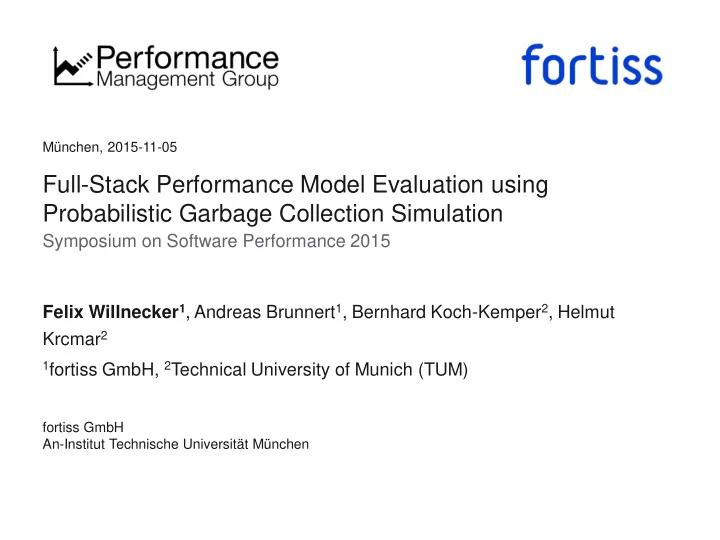

München, 2015-11-05 Full-Stack Performance Model Evaluation using Probabilistic Garbage Collection Simulation Symposium on Software Performance 2015 Felix Willnecker 1 , Andreas Brunnert 1 , Bernhard Koch-Kemper 2 , Helmut Krcmar 2 1 fortiss GmbH, 2 Technical University of Munich (TUM) fortiss GmbH An-Institut Technische Universität München
Agenda • Introduction • Memory management simulation • SPECjEnterpriseNEXT • Evaluation • Conclusion and Outlook 2 pmw.fortiss.org München, 2015-11-05
Introduction • Performance model generators available in academia and industry 1 (Brunnert/Krcmar 2015) • Focus on Central Processing Units (CPU) and network demands (Brunnert/Krcmar 2015, Brosig et al. 2009) • Hard disk drive concepts exists for generators, but measurement approach and evaluation missing • Currently available memory model focuses on static memory allocation • Holistic performance models must cover all relevant resources of an application (Speitkamp/Bichler 2010) • Heap and garbage collection model extension missing • Closing the gap with extensions to the RETIT performance model generator and full- stack evaluation based on SPECjEnterpriseNEXT 1 https://www.retit.de/ 3 pmw.fortiss.org München, 2015-11-05
Memory Management Model Using PassiveResources in PCM • Each CompositeStructure contains a Heap component • This Heap component manages the total memory capacity as PassivResource • Each SEFF begins with an ExternalCallAction allocating the mean amount of Heap allocated • Each SEFF ends with ExternalCallAction releasing the same amount of Heap again 4 pmw.fortiss.org München, 2015-11-05
Static Memory Allocation Using PassiveResources in PCM • Allocation and release is modeled using AcquireActions and ReleaseActions • Both Actions are extended using ParemetricResourceDemands • The demand contains the number of bytes allocated or released 5 pmw.fortiss.org München, 2015-11-05
Using PassiveResources in PCM Simulating Static and Dynamic Memory Models 6 1 1 13 130 25 259 37 388 pmw.fortiss.org 49 517 61 646 73 775 85 904 97 1033 109 1162 121 1291 133 1420 145 Dynamic Memory Management 1549 157 Static Memory Allocation 1678 169 1807 181 193 1936 205 2065 217 2194 229 München, 2015-11-05 2323 241 2452 253 2581 265 2710 277 2839 289 2968 301 3097 313 3226 325 3355 337 349 3484 361 3613 373 3742 385 3871 397 4000 409 4129 421 4258 433 4387 445 4516 457 4645 469 4774 481 4903 493
Dynamic Memory Management Using PassiveResources in PCM • Added two new operations – triggerMinorGC for minor garbage collection events – triggerMajorGC for major garbage collection events • Using GarbageCollectionListener for monitoring garbage collection events in JavaEE • CPU usage depending on the number of bytes released 7 pmw.fortiss.org München, 2015-11-05
Dynamic Memory Management Trigger from usage model • Measured mean time between major and minor garbage collection events • Trigger release from usage scenarios using an OpenWorkload • Parameter of the call is the mean bytes released per major or minor garbage collection event 8 pmw.fortiss.org München, 2015-11-05
SPECjEnterpriseNEXT • Pre-Release version of SPECjEnterpriseNEXT used for evaluation • Insurances for vehicles are calculated by this benchmark • A vehicle service holds available vehicles • An agent service calculates quotes based on customer and vehicle • HTML/AJAX based user interface allows registration, adding vehicles and calculating quotes by calling the two web services • Purchase not yet implemented • Installation on three VMs using Wildfly 8.1 • Faban 1.3 based Insurance driver part of the benchmark • Evaluation conducted with 100-160 concurrent users 9 pmw.fortiss.org München, 2015-11-05
SPECjEnterpriseNEXT Evaluation deployment 10 pmw.fortiss.org München, 2015-11-05
Evaluation CPU Utilization Replay Resource User Metric Insurance Domain Vehicle Service Insurance Agents Measured utilization 43.80% 51.57% 46.13% 100 Simulated utilization 40.48% 48.29% 43.04% Relative error 7.58% 6.38% 6.70% CPU Measured utilization 70.19% 77.91% 71.73% Simulated utilization 64.75% 77.25% 68.88% 160 Relative error 7.75% 0.85% 3.97% Measured utilization 1458.58 MB 1435.41 MB - 100 Simulated utilization 1299.22 MB 1319.41 MB - Relative error 10.93% 8.08% - Heap Measured utilization 1360.19 MB 1304.46 MB - Simulated utilization 1296.29 MB 1317.88 MB - 160 Relative error 4.70% 1.03% - Measured utilization 0.23% 0% 0% 100 Simulated utilization 0.21% 0% 0% Relative error 10.72% 0% 0% HDD Measured utilization 0.34% 0% 0% Simulated utilization 0.35% 0% 0% 160 Relative error 0.65% 0% 0% 11 pmw.fortiss.org München, 2015-11-05
Conclusion & Outlook • Holistic performance model containing – CPU, Network, Heap (incl. GC) and HDD used – Deployment Units considered in distributed setup • Probabilistic approach delivers sufficient results for Heap simulation • Outlook – ActiveResource instead of PassiveResource in PCM => Reducing the number of measurement probes – Garbage collection space simulation instead of mean bytes released – Garbage collection threshold instead of interarrival time – Evaluation with different use cases 12 pmw.fortiss.org München, 2015-11-05
References • Brunnert, A.; Krcmar, H. (2015) : Continuous Performance Evaluation and Capacity Planning Using Resource Profiles for Enterprise Applications. In: Journal of Systems and Software, (2015). • Brosig, F.; Kounev, S.; Krogmann, K. (2009) : Automated Extraction of Palladio Component Models from Running Enterprise Java Applications. Paper presented at the Fourth International ICST Conference on Performance Evaluation Methodologies and Tools, pp. 10:1-10:10. • Speitkamp, B.; Bichler, M. (2010) : A Mathematical Programming Approach for Server Consolidation Problems in Virtualized Data Centers. In: Services Computing, IEEE Transactions on, Vol. 3 (2010) No. 4, pp. 266-278. 13 pmw.fortiss.org München, 2015-11-05
Q&A Felix Willnecker willnecker@fortiss.org performancegroup@fortiss.org pmw.fortiss.org 14 pmw.fortiss.org München, 2015-11-05
Recommend
More recommend